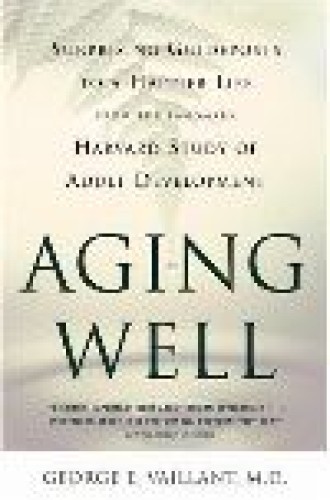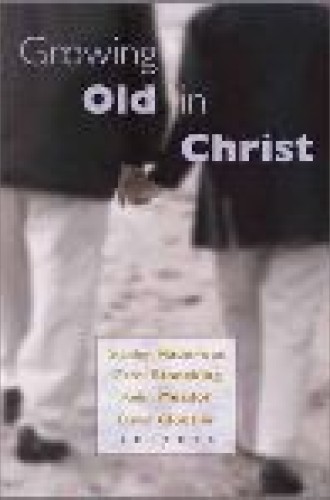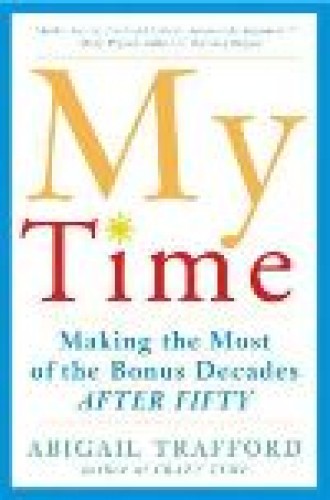Good old days?
Life expectancy in the developed world has nearly doubled in the past century. By 2010 one-third of all Americans will be between the ages of 50 and 80. This phenomenon has raised a new set of questions. Should old age, like childhood, be regarded as a separate stage of life, one offering a distinct set of problems and requiring a distinct set of virtues? Are the added years a burden or a gift? What share of our medical resources should go to the elderly? Is old age a period of inexorable decline or of spiritual growth? Most reflection on these questions has been done by secular thinkers, but some work is beginning to be done in theological circles.
In Aging Well, George E. Vaillant, a psychiatrist who directs the Harvard Study of Adult Development, offers models for “how to live from retirement to past 80—with joy” based on what is perhaps the longest longitudinal study in the world. Three cohorts of men and women (268 socially advantaged Harvard men born about 1920, 456 socially disadvantaged inner-city men born about 1930, and 90 middle-class, intellectually gifted women born about 1910) have been followed continuously for six to eight decades. Vaillant organizes his material clearly and writes without jargon, and he uses the stories of various participants as illustrations.
Vaillant devotes two chapters to questions of special interest to those concerned with religion. Does wisdom increase with age? It’s conventional to link wisdom with age and experience, but Vaillant finds the evidence mixed. Wisdom is the opposite of being self-absorbed, but old people can, like King Lear, be narcissistic. There is no evidence that the majority of older adults are wiser than the young.
Do people become more spiritual and religious as they age? Here again, the evidence is not clear. Vaillant’s research has led him to conclude that “the last years of life without hope and love become a mere sounding brass or tinkling cymbal.” He expected that faith, the third element in St. Paul’s triad, would increase, but he found that many people move away from, not toward, religion as they age. This is especially true of the “fortunate old”—those who are healthy and surrounded by loved ones, who have a spouse and a happy marriage, and thus less need for the social supports that the church provides.
In addition—and contrary to the stereotype—older people often become less dogmatic as they age and express less interest in the tenets of the faith that the churches preach. Most still acknowledge a power greater than themselves and they may have a deepened spirituality, but Vaillant concludes that “the presence or absence of either spirituality or religious adherence had little association with successful aging. It was hope and love rather than faith that seemed most clearly associated with maturity of defenses, with successful aging, and with generativity.”
Although Vaillant’s conclusions are intriguing, they are limited. His sample group is numerically small and lacking in diversity—Harvard men and intellectually gifted women are not typical of the population as a whole, and the inner city in the 1920s was largely white, as was Harvard. But his lively presentation and his method—extensive personal interviews with people over a long span of years—make this book a model for future efforts.
In My Time: Making the Most of the Rest of Your Life, Abigail Trafford, former health editor and now a columnist for the Washington Post, points out that Americans are enjoying a longer health span as well as life span. Many people now have ten more healthy years (or more) than people in previous generations, which makes 21st-century Americans biological pioneers. This extra time has come about so quickly that neither society nor aging individuals are prepared for it. Those between 50 and 80 ask themselves: What do we want to do with our extra time? How do we “find new ways to live and love and work at an age when [our] forebears would have been settling into a rocking chair?”
Trafford found, in conducting hundreds of interviews, that “my time” begins with a transition period similar to adolescence. It involves breaking away from former ways of living and experimenting with new activities in order to figure out what to do with the rest of one’s active life. But unlike teenagers, older people have no institutional structures to help them through this transition—at least not yet.
Trafford concludes that those who age well are the ones who develop their creativity, find ways to serve their communities and help others, and, despite losses, keep and forge strong relationships. Having a purpose and being connected to others are essential factors for happiness and well-being.
In the chapter “Exploring Romance,” Trafford relates a story that highlights the need for more rigorous ethical thought about what healthy use of “my time” means. A married retired man who finds his wife sexually unattractive tracks down a college girlfriend, a widow in the early stages of Alzheimer’s disease, and the two begin a passionate affair. As her dementia advances, he begins to search for other former girlfriends to replace her. In reporting this, Trafford does not bother to question the behavior, or note that the capacity for self-deception and exploitation does not shrink with age.
Growing Old in Christ is billed as “the first serious theological reflection ever on what it means to grow old, particularly in our culture and particularly as a Christian.” It comes close to providing a unified perspective on the subject, despite being a collection of essays. The writers draw on literature, philosophy and scripture as well as on sociological and psychological perspectives. The 14 essays are divided into three categories: “Biblical and Historical Perspectives on Aging,” “Critical Perspectives on Modern Problems of Aging” and “The Christian Practice of Growing Old.”
A Christian theology of aging faces two obstacles. First, Jesus died as a young man, and so he gave us no model for how to age. Second, Jesus at times downplayed the significance of family connections and obligations toward the elderly. To a man who had to bury his father, Jesus said, “Let the dead bury their dead.” To his mother at the wedding at Cana, he said, “Woman, what have I to do with you?” When told that his family wanted to see him, he replied, “Who are my mother and my brothers?”
Tackling the first problem, Richard B. Hays and Judith C. Hays argue that Jesus’ example of self-giving for the sake of others remains relevant to us throughout our lives.
As we grow old, “we should seek to discern how to give our lives for others.” The biblical witness stresses the similarity rather than the difference between the young and the old. “All followers of Jesus are to practice watchful waiting upon God across the span of their years.” This essay, the first in the book, sets out one of the volume’s major themes: the duty of the elderly to serve others.
D. Stephen Long changes the emphasis from the duties of the elderly to the church to the church’s duty to the elderly. He cites Jesus’ words on the cross commending his mother to the apostle John’s keeping as an example of care and concern for the old. Jesus remade the concept of family by creating the church, Long argues. Care of the elderly belongs not only to the biological family, society or individual, but also to the church. The welfare of the aged is also a problem of social justice.
Stanley Hauerwas and his associates largely deal with one segment of the elderly population—the “old old.” Most seniors would agree that 80 is when true old age, with its inexorable decline and loss, sets in. This is the part of the aging population exhibiting the greatest growth. In the United States the number of centenarians has gone from 15,000 in 1980 to 100,000 at the beginning of the 21st century.
Since the old old usually need special help and care, writing about this age group tends to be gloomy. Growing Old in Christ is no exception. But the gloom is of a particular kind. These essays make a large distinction between the place of the old in society and their place in the church. Only in the church, the writers argue, do old people find their rightful role and place. But that role, as defined here, may not necessarily be welcomed by all old people. Growing Old in Christ is written by people not yet in the “old old” age bracket and with little input from them. It would have benefited from the kind of research that underlies Vaillant’s book and, to a lesser extent, Trafford’s.
Hauerwas and Laura Yordy claim that the most striking feature of growing old in America is loneliness. “Friendship with the elderly is almost unimaginable, as our very conception of what it means to be old is isolation.” Old friends move away or die, and take with them “the confirmation of our identity.” Memory, often a comfort, can just as often inflict pain by reminding us of what we have lost or have failed to do. New friendships tend to be shallow, focused on sharing superficial pastimes rather than on the mutual development of character.
This view of aging and the place of the church aligns well with Vaillant’s finding that organized religion is especially attractive for lonely old people, those with a tendency toward depressive illness and those whose childhoods were lacking in hope and love. But it’s noteworthy that Hauerwas and Yordy’s general view of the plight of the elderly in society is much darker than Vaillant’s, who based his conclusions on data and interviews.
Hauerwas and the other essayists are on firmer ground when they write of the importance of holding on to the Christian story, which gives meaning to individual stories and provides “rich resources to make possible friendship between the elderly and, perhaps most important, becoming and remaining friends with ourselves as we age.” Since Christian communities live by memory, and the church’s central feast is a feast of memory, the old have an essential role in the church. They are the keepers of the meaning, the repository and tellers of the story of the communion of saints.
Though Hauerwas and his collaborators realize that not all old people are wise, and that we cannot expect them to be, “there is no substitute for some old people in the church being wise. Someone must know how to tell the stories well.” In our society, the experience of the old has little value; in the church, a community of tradition, it has great value. Perhaps the most essential role of the elderly in the church, according to the writers in this book, is to be models for the young—models of continuing growth in virtue, of aging as “an opportunity for a rich life of service,” and of “how to grow old and die.”
People who have led virtuous lives usually do die well, as Joel James Shuman reminds us in “The Last Gift.” A good death, he says, “is finally nothing more or less than a death approached and performed in a manner consistent with a good, well-lived life. . . . Dying well is a morally significant act insofar as it bears evangelical witness to our most profound theological convictions.”
Unfortunately, Shuman’s essay is an example of a prescriptive tone in these essays that becomes bothersome. One wonders if all this talk of the old “performing” a good death is a way of placing a burden on the old, adding another anxiety on those already anxious about many things. Shuman also has a prescription for care: he suggests that the young old—those no longer encumbered by raising children or meeting the demands of a profession—should be the ones in the church to care for elderly people who need help. And, indeed, many of them already do so. But should we fault the young old when they want to travel or enjoy the pleasures of leisure? Hasn’t the church long insisted that people have different gifts, and that the faithful exercise of those diverse gifts, not age-based assignments, together builds the body of Christ?
Growing Old in Christ makes an excellent start at formulating a theology of aging and defining the relationship between the elderly and the church. One hopes that subsequent books on faith and aging will engage the social research, allow the old to speak more for themselves, and moderate prescription with description.







